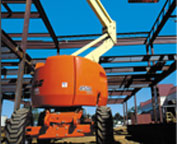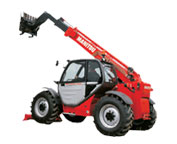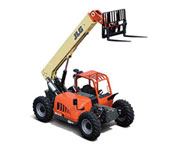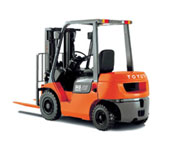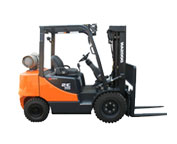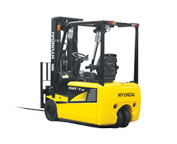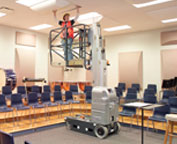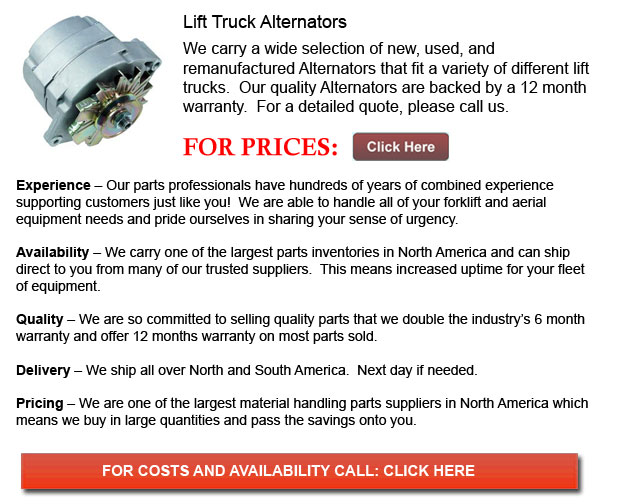
Forklift Alternators - A device used so as to change mechanical energy into electric energy is actually known as an alternator. It can perform this function in the form of an electrical current. An AC electrical generator can in principal likewise be labeled an alternator. Then again, the word is typically used to refer to a small, rotating device powered by internal combustion engines. Alternators which are located in power stations and are driven by steam turbines are actually known as turbo-alternators. Most of these devices make use of a rotating magnetic field but sometimes linear alternators are also used.
A current is produced inside the conductor when the magnetic field all-around the conductor changes. Normally the rotor, a rotating magnet, spins within a set of stationary conductors wound in coils. The coils are situated on an iron core referred to as the stator. If the field cuts across the conductors, an induced electromagnetic field also called EMF is generated as the mechanical input causes the rotor to turn. This rotating magnetic field generates an AC voltage in the stator windings. Typically, there are 3 sets of stator windings. These physically offset so that the rotating magnetic field produces 3 phase currents, displaced by one-third of a period with respect to each other.
In a "brushless" alternator, the rotor magnetic field could be made by induction of a permanent magnet or by a rotor winding energized with direct current through slip rings and brushes. Brushless AC generators are usually found in bigger devices compared to those utilized in automotive applications. A rotor magnetic field can be induced by a stationary field winding with moving poles in the rotor. Automotive alternators usually utilize a rotor winding which allows control of the voltage produced by the alternator. This is done by changing the current in the rotor field winding. Permanent magnet machines avoid the loss because of the magnetizing current inside the rotor. These devices are limited in size because of the cost of the magnet material. The terminal voltage varies with the speed of the generator as the permanent magnet field is constant.
 Click to Download the pdf
Click to Download the pdf
Forklift Parts
Fork Positioner for Forklift
Forklift Fork Positioner - The fork positioner is a hydraulic apparatus which can allow the driver to operate the lift truck without leaving the seat. They are made out of high quality materials and are meant to withstand the most challenging operations and work surroundings. Side shifting units have the added ability to laterally position the entire load or the...
More
Parts for Container Forklift
Container Forklift Parts - A forklift is a helpful piece of industrial equipment in warehouse and distribution operations in order to keep and transfer products. Their ground-breaking design allows them to fit into constricted spaces whilst maintaining agility. The usual function of a lift truck is to be able to transport heavy cargo in the loading and unloading of goods,...
More
Manitou Forklift Parts
Manitou Forklift Parts - The well-known company, Manitou, specializes in the making of forklifts, skid steer loaders, telehandlers plus various types of heavy duty equipment. The numerous different models accessible are meant for particular companies so as to suit all the needs of agricultural, mining and industrial trades. As the needs of these trades continue to develop, the equipment production...
More
JLG Forklift Parts
JLG Forklift Parts - Following retirement in the late 1960's, John L. Grove set out on a cross country RV voyage. After spending numerous years establishing his family built crane company with his brother, John had no idea that this journey would bring about the rise of JLG Industries, Inc. The world leader of mobile aerial work platforms and precision...
More
Parts for Electric Stacker
Electric Stacker Parts - A kind of compact forklift, the electric stacker is utilized to work in smaller areas, making lifting and loading rather easier on the warehouse employee. Often wide, but flat things like for example pallets, slabs, and tubes are moved using this piece of equipment. There are metallic prongs jutting out horizontally from the body of the...
More
Parts for Counterbalance Forklifts
Counterbalance Forklift Parts - In the material handling industry counterbalance lift trucks are extremely common pieces of equipment. They could be commonly found in factories and warehouses all over the globe. The leading forklift makers like Mitsubishi, Linde and Toyota all create counterbalance forklifts. They are obtainable in different fuel alternatives like for example gas, diesel or electric. Typically, a...
More
Parts for Warehouse Forklift
Warehouse Forklift Parts - A crucial part of the supply chain is the Warehouse Management System. It primarily aims to control the storage of materials and the movement of products in a warehouse, together with the related operation comprising shipping, receiving, order picking and put away. The Warehouse Management System directly optimizes stock put away based upon real-time information regarding...
More
High Reach Forklift Parts
High Reach Forklift Parts - Utilized in almost all warehouse operations, boat yards or industrial construction sites, the forklift is a vital part in order to help pick up and transport supplies. The reach feature of a lift truck could help enhance the applications that the forklift could accomplish like for instance stacking pallets on a high shelving unit. A...
More


![]() Click to Download the pdf
Click to Download the pdf

